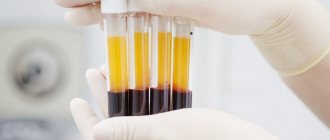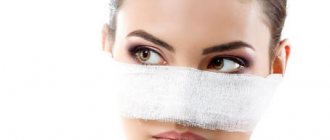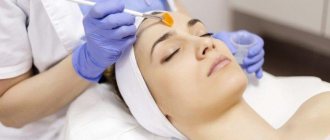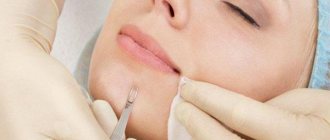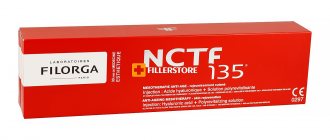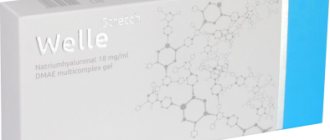Electrolysis is the only permanent hair removal method known today; it has been tested over time and is 100% safe.
This method was first tested by American ophthalmologist Charles E. Michael in 1875 to remove ingrown eyelashes. In subsequent decades, electrolysis was introduced into practice as a cosmetic rather than a medical procedure. And only 100 years later, an electric hair removal device was released, which had an electronic display and many different operating modes.
What is electrolysis?
Electrolysis is
Hair removal, which occurs by applying a weak current to the hair follicle. Thanks to the manipulations, the hair follicle is thermally treated, the capillaries die, which gives a 100% result of irreversible hair removal. The protein in the hair follicle dies, making it impossible for new hair to grow.
The process of getting rid of unwanted hair is as follows. A sterile needle is inserted to a depth of 5 millimeters, through which current flows. The holding time of the needle depends on the type of procedure, the characteristics of the skin and the structure of the hair. Today, the medical community recognizes only this method, which removes hair permanently. All other hair removal methods provide only temporary results.
Consequences
The consequences of electrical hair removal can be not only positive, but also negative. Manifestations such as swelling, bruising, scars (signal about incorrect selection of discharge power), reddish spots (quickly disappear), acne and itching in the bikini area (a natural reaction of the skin to exposure to electricity; scratching is strictly forbidden, as the itching will only intensify and may scarring) are called complications.
They are provoked by interference with the natural processes of hair growth, the actions of a doctor, or the skin’s own properties and reactions.
How did electrolysis come about?
Removing unwanted hair has always been important. Before the invention of electrolysis, people subjected their bodies to amazing and sometimes dangerous manipulations in the fight against unwanted hair. Various poisons, hot needles were injected under the skin, and injections were made using various herbs. Such experiments sometimes led to tragic consequences. Therefore, hair removal was done only for medical reasons.
Ophthalmologists have made a big breakthrough in hair removal. They were the first to come to the conclusion that hair grows from a bulb, which, if damaged, can get rid of excess hair. In 1875, using electrolysis, American ophthalmologists began performing procedures to remove ingrown eyelashes. A metal plate with a positive charge was placed on the patient's face, and a needle with a negative charge was inserted into the eyelash follicle. The unwanted hair was removed due to a chemical reaction and did not grow back.
Every year, doctors sought to improve and modernize hair removal technology. Gradually, the technology went beyond medicine and penetrated into cosmetics and hairdressing studios. In pursuit of profit, masters who do not have sufficient knowledge often harm their clients. So in 1970, the electrolysis method began to be taught at medical universities around the world. Since 2000, devices have appeared for each type of procedure.
Electrolysis has strong competition in the cosmetic industry. But the main distinguishing feature of this procedure is permanent hair removal, which laser or photoepilation cannot boast of.
Types of electrolysis
Electrolysis
Electrolysis is a method of hair removal using direct current. This method of hair removal is also called the galvanic method. To achieve the result, it is necessary to create a galvanic reaction using several electrodes. A metal plate soaked in a special solution is placed in the patient’s hand to improve the passage of the positive charge. A negative charge passes through the needle. In the ongoing galvanic process, an alkali is formed, due to which hair removal occurs.
This method uses multiple needles during the hair removal process. The formation of an alkali can take up to several minutes, and each follicle should be processed several times. This method is best suited for those with fair hair and sensitive skin.
This method has a number of disadvantages. For example, you can get severe skin burns. During the hair removal process, a needle penetrates the skin under the influence of high temperatures. The pain of the procedure will depend on the individual characteristics of the body. Electrolysis performed by an inexperienced technician can lead to a sad outcome. Improper use of the device may result in a short circuit.
The essence of electrolysis is to insert a needle under the skin, due to which infections can enter the body. It could be a dirty needle, or a needle made of poor quality material. Infections may also appear after the procedure. Depending on the individual characteristics of the body, the skin healing process can be lengthy. Since micro-holes remain after the procedure, there is a high risk of infection.
An illiterate master can leave scars and scars at the site of the procedure. Scars are formed if the needle does not enter the follicle, but the surrounding tissue. After the procedure, pigmentation may appear. During the procedure, various chemical reactions occur. The appearance of pigmentation most often occurs in those with dark skin.
Thermolysis
Thermolysis is a method of thermal treatment of the hair follicle. During the removal process, there is a sharp increase in alternating current, due to which the tissues heat up faster, and the procedure time is significantly reduced. This method is the most popular. The processing time for one hair follicle is only 2 seconds. Due to thermolysis, the maximum effect is achieved. This procedure is suitable for all skin types and any hair type. The disadvantages include a high risk of skin burns. The procedure is extremely painful.
Flash thermolysis
Flash thermolysis is a new type of classical thermolysis. The procedure is similar to thermolysis, but the time of exposure to the hair follicle is reduced. This procedure uses high current frequencies, due to which the processing time of one bulb is reduced to 1 second. The needle is completely isolated, making the procedure as painless as possible. This hair removal method is used for the face and bikini area. Anesthesia with injections is not used in this procedure.
Blend
Blend is a method that includes the work of thermolysis and electrolysis. The hair follicle is affected by chemical reaction and coagulation.
The thermal effect increases the formation of alkali, resulting in reduced exposure time on the hair follicle. This method is suitable for removing thick and ingrown hair.
What results can you expect? Photos before and after
Electrolysis of the upper lip. Before and after
Electrolysis of armpits. This is done extremely rarely. Photos before and after
Electrolysis of the bikini area
Electrolysis of the lower leg. Before and after
Bikini electrolysis
The bikini electrolysis procedure is very popular. This is the only way to remove unwanted hair permanently. Before starting the procedure, the specialist must conduct a test on a small area of skin. This is necessary to adjust the device to the characteristics of the body. The procedure takes up to 40 minutes. It will take several sessions to get rid of hair forever. Since electrolysis is a targeted effect on the hair follicle, it is not possible to remove all hair in one session.
Important!
The procedure for removing unwanted hair should be carried out by a certified specialist with medical education. Before starting the procedure, you should make sure that the equipment is sterile. Since the procedure is carried out with penetration into the deep layers of the skin, there is a risk of infection.
Hair removal will depend on the characteristics of the body. From 5 to 15 procedures may be required. Efficiency will depend on hormonal levels, hair thickness, and skin type.
Contraindications!
The procedure has a number of contraindications. It should be avoided in cases of skin diseases in the acute or chronic period. People with diabetes should refuse. The procedure cannot be performed in cases of varicose veins at the site of the procedure. People with heart problems are strictly prohibited from attending the procedure. It is worth abstaining in case of acute infectious diseases. The procedure cannot be performed during pregnancy and lactation.
The cost of the procedure is quite high. It includes the cost of the needle, anesthetic injection and the time of the procedure.
Preparation
Preparing for the procedure will not take much time, and for some it will even simplify daily hygiene, since you cannot use wax strips or an electric epilator, and shaving your hair is also prohibited. To successfully complete the procedure, a hair length of 2 to 5 mm is required, so you need to either shorten what you have or not shave for several days.
Why can our articles be trusted?
We make health information clear, accessible and relevant.
- All articles are checked by practicing doctors.
- We take scientific literature and the latest research as a basis.
- We publish detailed articles that answer all questions.
General recommendations for preparation:
- Do not take hormonal medications for about a week. When taking hormonal contraceptives, it is best to carry out the procedure after the end of your period and before starting a new cycle of pills.
- A week before the session you should not visit baths, saunas, solariums or sunbathe on the beach.
- On the day of the procedure, during morning hygiene procedures, you should treat the skin in the planned intervention area with a scrub.
- A few days before the event, examine the treatment area and eliminate ingrown hairs without pulling them out.
With proper preparation and following the recommendations, hair removal will take place with minimal consequences, or even without them at all.
Electrolysis contraindications
The procedure should be taken as seriously as possible, because there is a risk of serious problems. The procedure is classified as physiotherapeutic and has a number of contraindications.
Asthma
This disease is not a reason to refuse the procedure. But people with asthma need to prepare for the procedure, as attacks may occur during the process. Before starting the procedure, you should describe as accurately as possible all symptoms and frequency of attacks. This will be required to make a decision in case of complications. At the beginning of the procedure, the current intensity is minimal, and the current intensity is increased only with the consent of the patient.
Pregnancy
During this period, it is recommended to avoid any cosmetic interventions. The first trimester is the most important in the process of forming the unborn child, so there is a complete abandonment of the electrolysis procedure. Further, the procedure can be completed after consultation with your doctor. The procedure is not performed in the chest and abdomen area. Painful sensations arising during the procedure can provoke muscle spasms, which can provoke a number of complications for the unborn child.
Heart
The procedure should be avoided if you have heart disease. In case of heart disease, the movement of blood flow is disrupted; additional intervention with electricity can provoke serious consequences.
Phlebeurysm
The procedure should be avoided if there is local varicose veins. Electrical impulses can complicate the course of the disease. But you should not completely abandon the procedure.
Infections
When infectious diseases occur, a person’s immunity weakens. There is a risk of serious consequences. The procedure can be carried out, but at the beginning there is a written agreement of both parties about the possible consequences.
Hemophilia
Hair removal occurs by penetrating the needle under the skin. An inaccurate hit may cause bleeding. Therefore, in cases of poor blood clotting, the procedure is contraindicated.
Arterial pressure
There are no contraindications for refusing the procedure. But before starting, you should warn a specialist, since pain can cause neurosis and increased pressure.
Diabetes
This disease is characterized by decreased immunity and the possibility of rapid regeneration. A very intense effect on the skin can cause burns. Violation of the technology of the procedure can cause a number of complications. Therefore, you should avoid electrolysis.
Pacemaker
The electrolysis device may interfere with the pulse frequency of pacemakers, so the procedure is prohibited.
Lactation
It is not recommended to carry out the procedure during lactation. You cannot use painkiller injections, so the procedure will be painful.
Menstruation
During this period, the sensitivity of the body is at a high level, so it is better to refrain from the procedure, as the sensations can be very painful.
Metal implants
Metal is a conductor of electricity. If there are foreign metal bodies in the body, the procedure is contraindicated.
Nervous system diseases
In case of exacerbation of diseases associated with the central nervous system, you should refrain from the procedure. Pain during the procedure can disrupt the patient's psychological comfort and contribute to unequal distress.
Leather
There should be no warts, acne, herpes, fungal diseases, burns, open wounds, or scars at the site of the procedure.
Epilepsy
For this disease, the procedure should be carried out under the supervision of the attending physician to eliminate possible occurrences of epileptic seizures.
Application anesthesia (occlusive dressing/occlusion).
Used for pain relief:or large areas of the body such as:- shins;
- hips;
- shoulders and forearms;
or where sensitivity is not clearly expressed:
- usually this is the chest area;
or before injection anesthesia - to reduce pain during injection (if the pain threshold is very low):
- armpits;
- classic bikini;
- deep bikini;
- intergluteal zone;
- anus.
The main disadvantages of topical anesthesia are as follows:
- in a short duration of action after removing the film;
- often the depth of penetration of the anesthetic (spray/gel/cream) is not enough for complete anesthesia - slight sensitivity remains;
- sometimes unevenly anesthetized/weakly anesthetized areas remain due to the uneven distribution of the anesthetic under the film;
Electrolysis procedure
Before starting the procedure, the area of skin that will be manipulated must be disinfected. This is necessary to protect the skin from infection during the procedure. This is followed by local anesthesia. The most commonly used is lidocaine. This could be a drug injection or a spray. A cream is also used before the start of the procedure, but it should be applied an hour before the start of the session to achieve maximum effect.
A metal sheet is placed in the patient’s hands, which has a positive charge and creates a field for the electrode needle. Then the needle is inserted under the skin to the hair follicle. With the help of current and thermal burn, the bulb dies. The hair is removed using tweezers. After the procedure, the skin must be disinfected to prevent various infections from getting into open wounds.
Depending on the skin type, hair structure and personal characteristics of the body, the procedure time may vary. After the first procedure, hair growth is reduced by 20%. With an increase in the number of procedures, the result increases to 100%. With each procedure, the structure of the hair changes, it becomes thinner and lighter.
Follow-up skin care
After hair removal using an electric discharge, the following consequences appear on the skin:
- redness;
- itching;
- crusts.
What do we have to do
- Redness can last from several hours to 2 days, then it goes away on its own. But to speed up the process, it is recommended to wipe the skin with ice cubes. Instead of water, you can freeze a herbal decoction of chamomile or calendula.
- During the first two days, it is recommended to lubricate the skin surface with Chlorhexidine, and after it dries, apply talc.
- Itching is caused by the fact that, under the influence of an electric current, moisture evaporates and the skin dries out. To relieve discomfort, the skin should be treated with calendula tincture or aloe vera leaf pulp 3-4 times a day.
- The resulting crusts will remain on the skin for 7–9 days. During this period, it is important not to remove them forcibly, otherwise scars will form. After the natural peeling of the crusts, the skin must be lubricated 2 times a day with a healing, anti-inflammatory agent (Levomikol, Methylurocil, zinc ointment, etc.).
It is important not to tear off the scabs formed during the procedure to eliminate the possibility of scars.
What not to do
To avoid other unpleasant consequences after electrolysis, you need to adhere to certain restrictions, namely:
- Do not wet the treated area of skin for the first 24 hours;
- During the week you cannot visit swimming pools, baths and saunas, or take a hot shower or bath;
- For 2–3 weeks, it is necessary to protect the skin from ultraviolet radiation, i.e., do not sunbathe and avoid solariums. Otherwise, pigment spots may form on the skin. Therefore, when going outside, exposed areas of the body should be lubricated with sunscreen with an SPF of at least 30 units.
Electrolysis: pros and cons
Advantages of the procedure:
- Instant effect. Not all hair removal procedures can claim that hair will disappear immediately.
- Durability. This is the only medically recognized procedure for permanent hair removal.
- Electrolysis can remove any type of hair. Ingrown, thick, thin, light.
- The oldest type of hair removal procedure. This procedure has a history of over 100 years of ups and downs.
- Has an optimal price-quality ratio.
Flaws:
- For complete hair removal, a minimum of 5 procedures will be required.
- Procedure time . Depending on individual indicators, the procedure can last up to 3 hours.
- The procedure is painful. To perform the electrolysis procedure, it is necessary to treat the area with an anesthetic. But the pain does not go away completely; with the help of medication, it becomes more tolerable.
- Insufficient qualification of the master. The result of the procedure depends on the penetration of the needle under the skin. Incorrect insertion of the needle can not only fail to produce results, but also cause serious harm to the patient.
- Scarring. This procedure leaves noticeable scars. For a speedy recovery, the skin should be treated with special ointments for several weeks.
Where to do it - at home or in the salon?
Only a cosmetologist knows everything about electrolysis. He must have not just skills and experience, but also good training. On sale you can find a huge number of devices designed for this technology. They have low power. Advertising convinces that the devices are effective and completely safe. In practice, they can only remove fine hairs.
Only a specialist can carefully select the pulse power. This will allow complete removal. It is better to choose professional service rather than using household “toys”.
Electronic hair removal is truly unique. This is an extensive selection of equipment and capabilities. Some people believe that you can remove hair at home. In fact, this is not prohibited, however, it is better to entrust the work to real specialists in their field. They guarantee a positive outcome and that the skin will not be infected with pathogenic bacteria.
Electrolysis above the lip
This procedure is suitable for any hair type. The result will be permanent hair removal. You should prepare before the procedure. The effective hair length should be approximately 15 millimeters. Germination time will also play a big role. It should be up to 3 months. The speed of the procedure is low, since each hair is processed individually.
The first procedure for removing hair above the lip should take no more than 10 minutes. Such temporary restrictions are caused by possible swelling and swelling of the tissues. During the first procedure, not all hair is removed. Security requires this. The skin above the lip is quite thin and delicate; dividing current can lead to irritability and severe pigmentation.
The skin above the upper lip is very sensitive and requires pain relief. You should refrain from injections with painkillers, due to the large number of nerve endings. The optimal remedy is a cream that should be applied several hours before the procedure.
After the procedure, swelling and scars will be visible at the site of needle penetration. Swelling goes away on its own 36 hours after the procedure. The area where scars form should be treated with a special cream.
Prices
How much does electrolysis cost? Formation of prices is a rather complex process that takes into account many additional factors. The unit of measurement in this case is a minute, the cost of which can be either 10 or 50 rubles. This is explained by the presence of several methods, the use of various instruments, the classification of a specialist, and the availability of various additional services. If you still want to know the approximate costs of the procedures, the information in the table below may be useful to you.
| Zone | Upper lip | Bikini | Legs | Chin |
| Cost (rubles) | From 1000 | From 5000 | From 9000 | From 1000 |

